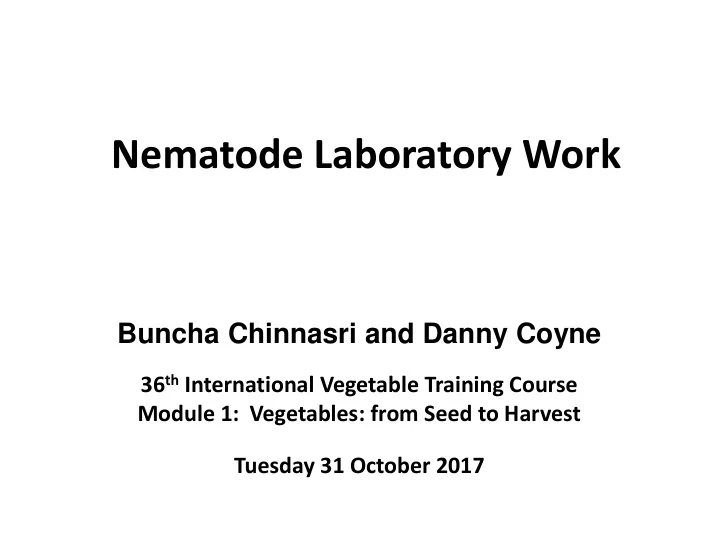

Nematode Laboratory Work Buncha Chinnasri and Danny Coyne 36 th International Vegetable Training Course Module 1: Vegetables: from Seed to Harvest Tuesday 31 October 2017
Soil Sampling Spade, hand trowel, scissors, screwdriver, soil auger or corer with a blade of 20-30 cm in length and 20-25 mm diameter (either complete cylinder or half cylinder).
Sampling Pattern Facts: 1. Nematodes are rarely distributed evenly in the field; patchy distribution 2. Samples should be collected from several areas in the field 3. Collect samples from both the poor growth and relative good growth areas Random sampling Systemic Sampling (Good only in small areas)
Sampling Times For predictive sampling: - Before planting ,or at the end of the previous cropping season For diagnostic sampling: - At the middle of the season and/or at the final harvest For perennials - During the active growing period (during rainy/growing season)
Number of Samples - Take enough samples to ensure “representative of the situation in the field” - The greater the number of soil samples, the more accurate the assessment will be. However, the availability of time and resources needs to be balanced e.g. Take 10 or up to 50 soil samples in an area of 0.5-1 hectare
Taking Root Samples • Collected at the same time with soil • Put in the same bag as soil; soil helps preserve the roots • Take 25-100 g of root per sample • Avoid sampling dead plants or in advanced stages of senescence (nematodes already migrate out!!)
Nematode Extraction 1.Extraction tray method 2.Root or leaf maceration method 3.Sieving method 4.Incubation method Note: Done as soon as possible as samples deteriorate over time
1. Extraction tray method Advantages: 1. Simple equipment (plastic basket etc.) 2. Good for mobile nematodes 3. Well adapted to local circumstances Disadvantages: 1. Not good for slow moving nematodes 2. Dirty extractions (if work with high clay content soil) 3. Take 3-4 days
Extraction tray method Three or four small feet glued to the base of the sieve (or basket)
1. Extraction tray method (with root samples) Then follow steps 5-10 in the Extraction tray method for soil sample
2. Root or leaf maceration method
Five-ten second burst for two times Then follow the steps in the Extraction tray method for root sample
2. Root or leaf maceration method • Advantage: - Does not require specialized equipment - Used when extracting nematodes from large plant parts • Disadvantage: - Time for macerating is critical, must be sufficient to allow nematodes to move out of plant tissues, not damage nematodes
3. Sieving method
Baerman Funnel Method
Baerman Funnel Method
2. Incubation method
Direct Examination from Plant Tissues - To easily assess whether nematodes are present in plant tissues e.g. Females of cysts & root-knot nematodes
Staining Nematodes in Plant Tissues Staining color: lactoglycerol+0.1% cotton blue or 0.05-0.1% acid fuchsin Destaining: Equal volume of glycerol and distill water + few drops of lactic acid Procedures 1. Slice thinly thick and bulky roots 2. Transfer the roots in muslin cloth 3. Place muslin cloth in boiling staining solution on a hot plate for 3 minutes 4. Remove muslin cloth and rinse in running water 5. Place stained roots in destaining solution
Staining Egg Masses by Phloxine B • Increasing the visibility of egg masses and enabling rapid count of egg masses of Meloidogyne • Egg masses are still viable after staining • Mixing 15 mg of Phloxine B + 1 liter of water (staining solution) • Place roots into the staining solution for 15-20 minutes
Recommend
More recommend